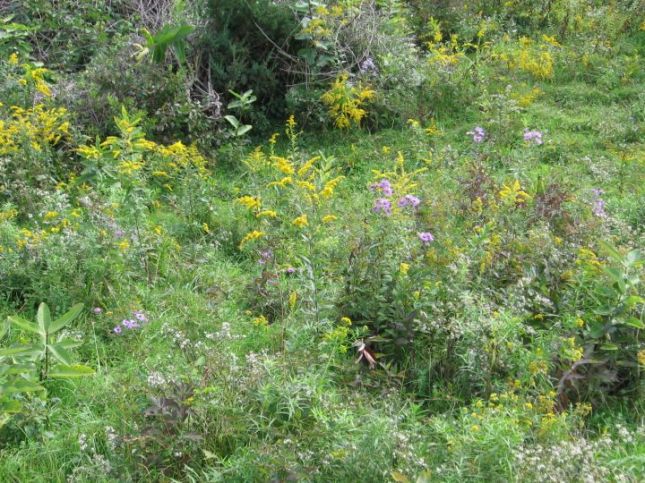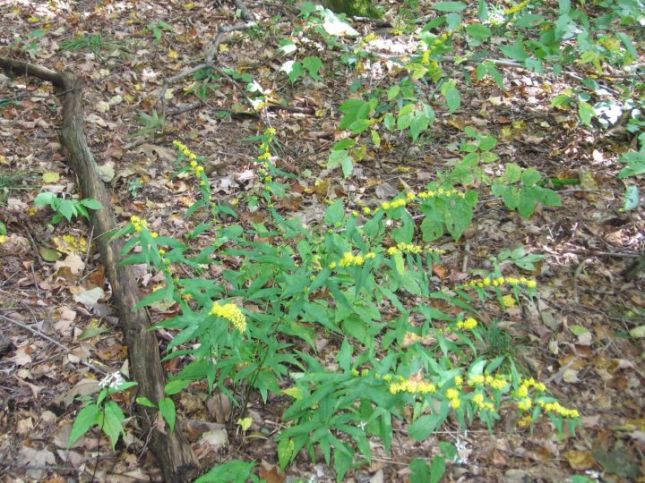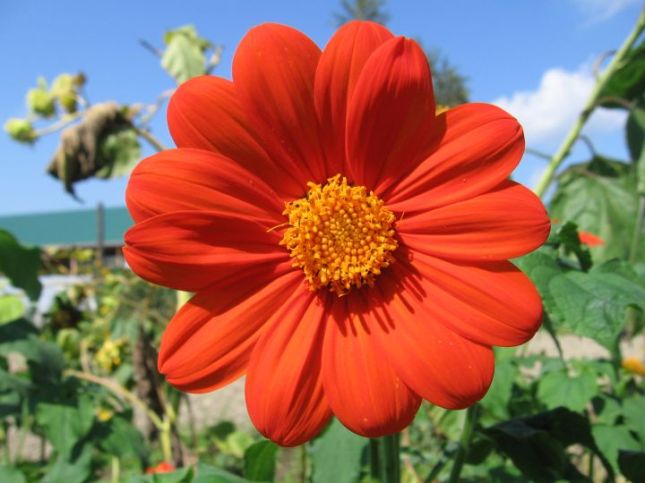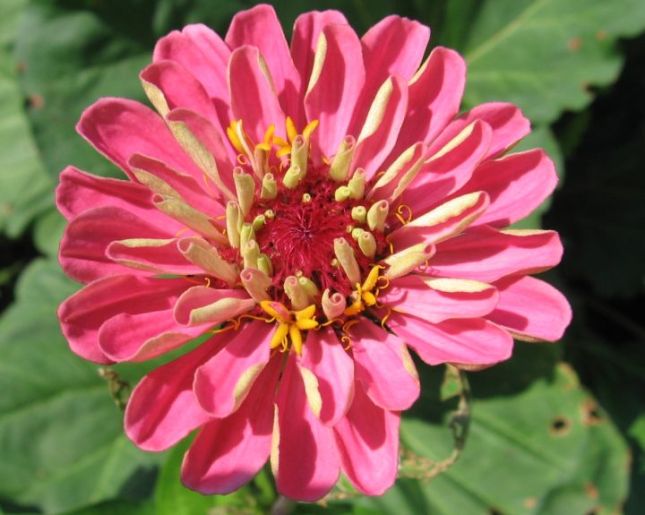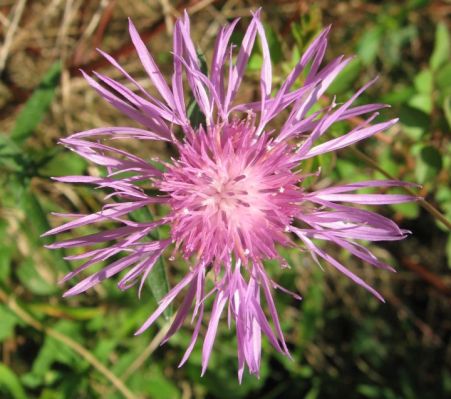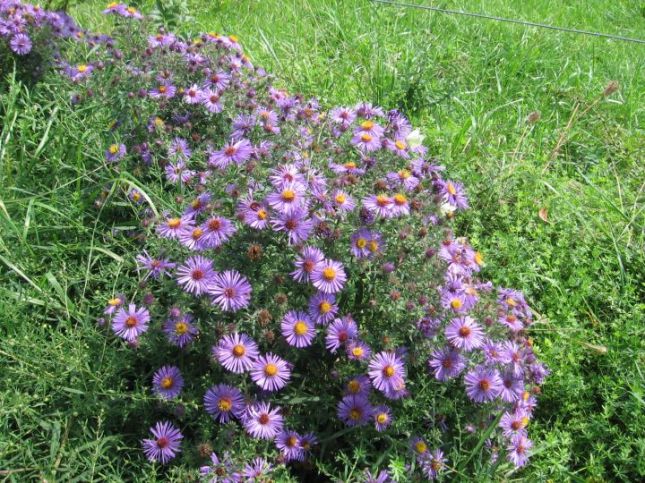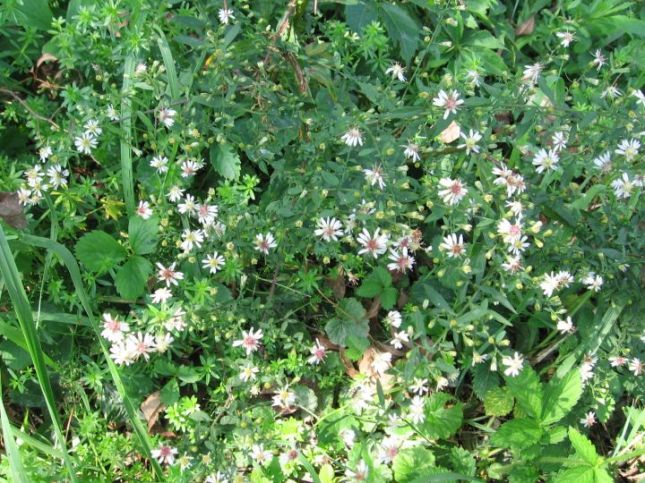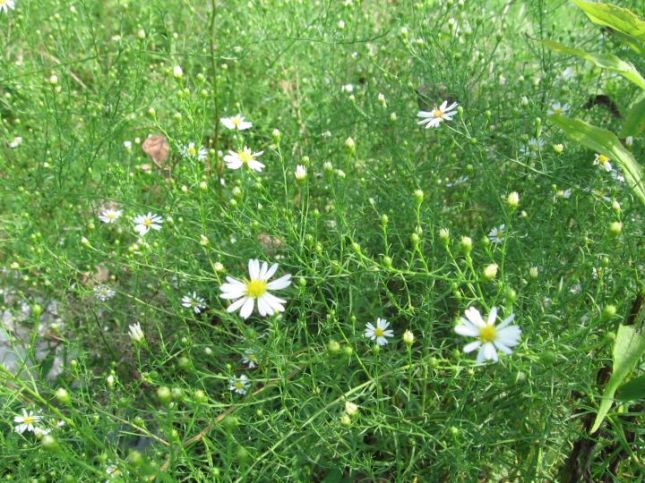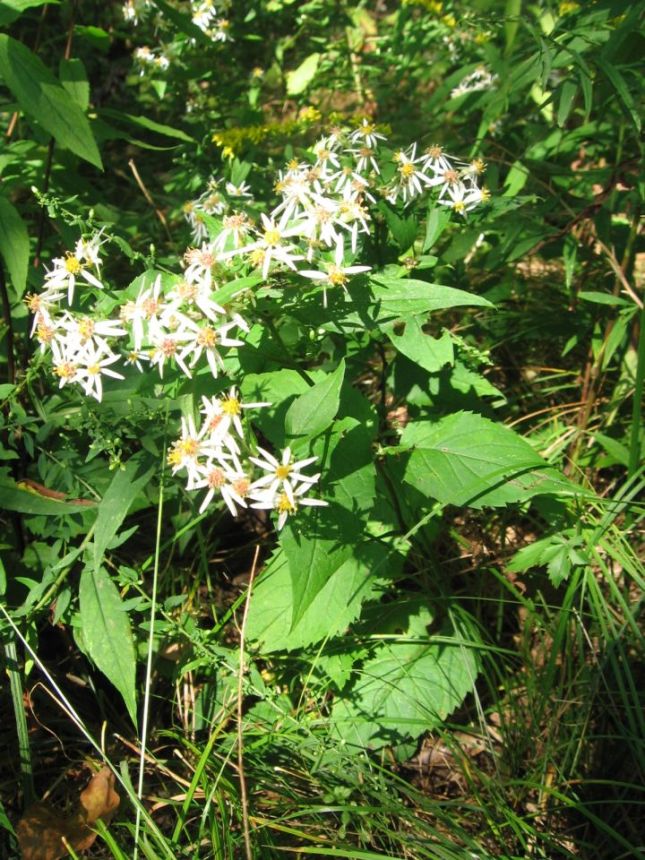Did I say in the last posting that we were at the peak of the fall flowers? Well, it has been a long peak and there are still many flowers in the Valley, as well as striking displays of fruits. So, I hope you will tolerate (and maybe even enjoy) another botanically focused blog.
For those of you who can’t visit Hawthorne Valley on a regular basis, this is how the landscape presents itself at the moment as seen from the Creekhouse on Harlemville Road:
 The pastures are still amazingly green. The trees are very slowly beginning to change color…
The pastures are still amazingly green. The trees are very slowly beginning to change color…
Along the edges (and in less intensively grazed areas) bloom a profusion of white, yellow and purple flowers of the aster family.
But before delving a bit deeper into the diversity of asters and their close relatives that make up the bulk of flowers at this time of the year, I would like to share some other noteworthy botanical discoveries from last week.
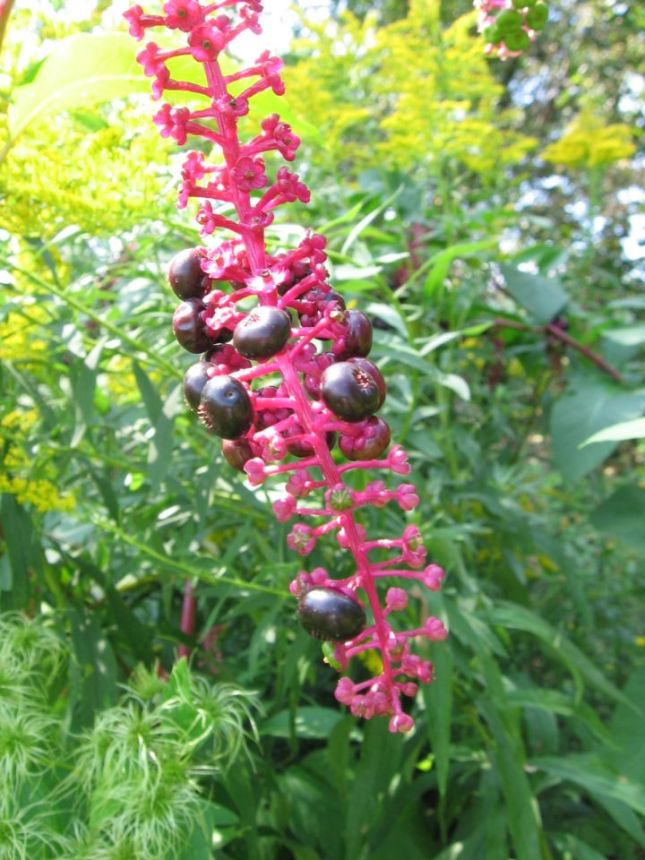 These gorgeous deep purple berries are the fruits of pokeweed (Phytolacca americana), which grows here and there along field edges. One can be seen north of Ben Ocean’s bridge behind the school. Pokeweed has dangerously poisonous roots, seeds, leaves and mature stems. However, in the spring, the young shoots are supposedly edible if prepared correctly. I have never tried to eat this plant but delight in looking at it… Pokeweed is native to our area, but sometimes has a tendency to grow profusely in places with bare soil and in some peoples’ gardens.
These gorgeous deep purple berries are the fruits of pokeweed (Phytolacca americana), which grows here and there along field edges. One can be seen north of Ben Ocean’s bridge behind the school. Pokeweed has dangerously poisonous roots, seeds, leaves and mature stems. However, in the spring, the young shoots are supposedly edible if prepared correctly. I have never tried to eat this plant but delight in looking at it… Pokeweed is native to our area, but sometimes has a tendency to grow profusely in places with bare soil and in some peoples’ gardens.
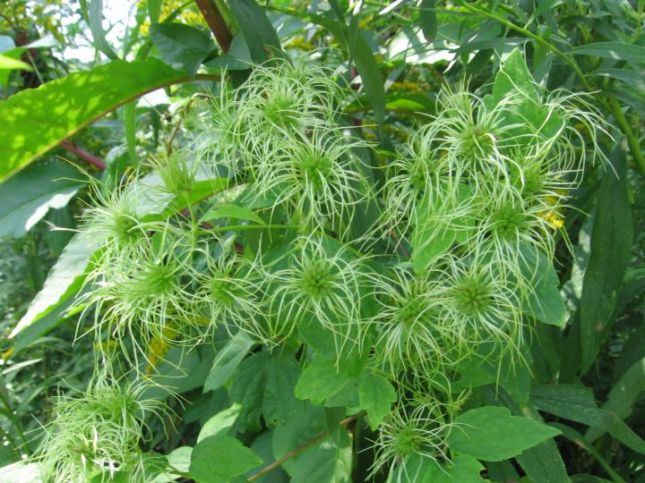 Another autumn delight for the eye are these hairy fruit heads of virgin’s bower (Clematis virginiana), which is usually found in moist soil near streams or in swamps.
Another autumn delight for the eye are these hairy fruit heads of virgin’s bower (Clematis virginiana), which is usually found in moist soil near streams or in swamps.
 These unusual fruiting capsules belong to a rare native plant called seedbox (Ludwigia alternifolia). We have found this species in the wild only in two places, so far: on the “Solar Field” here at Hawthorne Valley, where it grows in a wet spot along the eastern fence line (see picture below) and on another farm in Kinderhook. The seed capsules contain tiny seeds which readily germinate. Seedbox is now also thriving in the native plant garden at the Creekhouse.
These unusual fruiting capsules belong to a rare native plant called seedbox (Ludwigia alternifolia). We have found this species in the wild only in two places, so far: on the “Solar Field” here at Hawthorne Valley, where it grows in a wet spot along the eastern fence line (see picture below) and on another farm in Kinderhook. The seed capsules contain tiny seeds which readily germinate. Seedbox is now also thriving in the native plant garden at the Creekhouse.
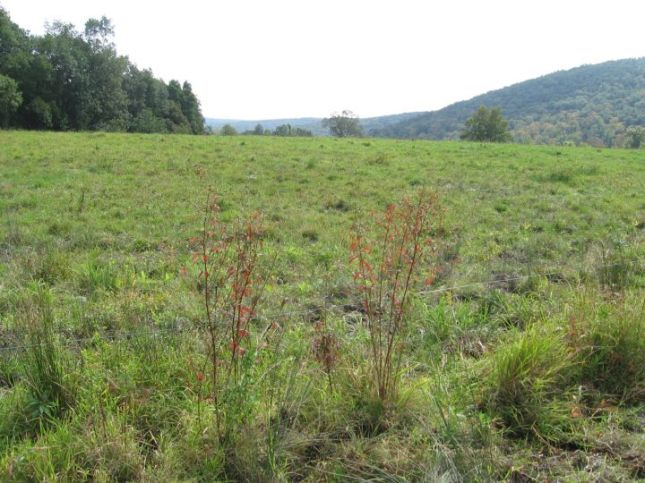 This is how seedbox looks from further away: the two reddish plants along the fence line.
This is how seedbox looks from further away: the two reddish plants along the fence line.
Nearby, on the North Hill, but also by the Firepond and in Indian Valley, as well as in many other fence rows, we currently have a phenomenal harvest of autumn olive (Eleagnus umbellata). Now there is an edible plant that is waiting to be picked! Raw, the berries are a bit too tart for my taste, but they make delicious fruit leather and I have some berries in the fridge waiting to be made into jelly…
 Autumn olive is originally from Asia and is considered an invasive plant because of its tendency to take over old fields, so you have to have no trepidations in harvesting as many berries as you can get your hands on.
Autumn olive is originally from Asia and is considered an invasive plant because of its tendency to take over old fields, so you have to have no trepidations in harvesting as many berries as you can get your hands on.
These red berries are found in the forest.
 They belong to a native plant called false solomon’s seal (Smilacina racemosa). Peterson’s Field Guide to Edible Wild Plants states that the berries are edible but are mildly cathartic (which means they might give you “the runs”) and I don’t know of anybody who eats them…
They belong to a native plant called false solomon’s seal (Smilacina racemosa). Peterson’s Field Guide to Edible Wild Plants states that the berries are edible but are mildly cathartic (which means they might give you “the runs”) and I don’t know of anybody who eats them…
Another plant with red berries growing in our forests is Jack-in-the-Pulpit.
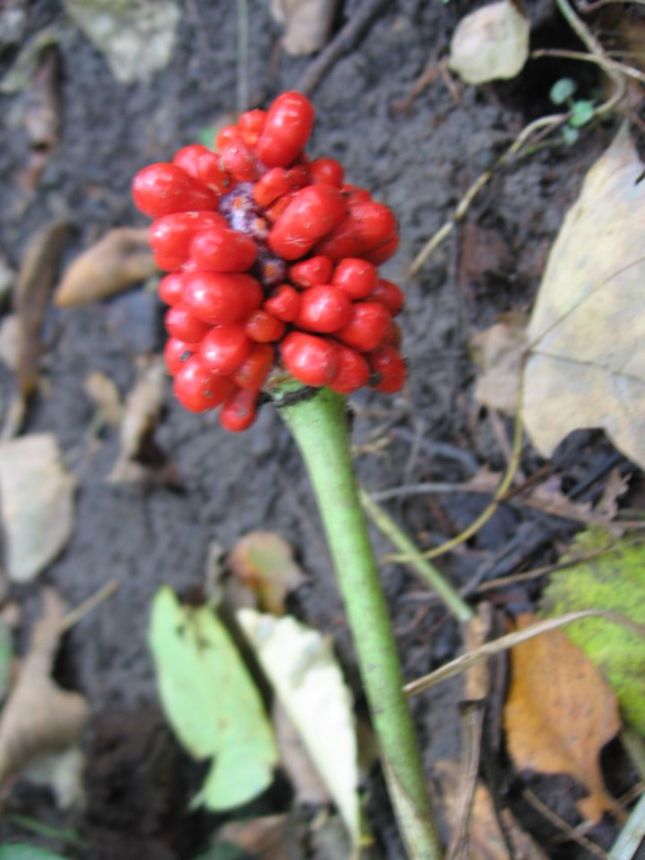 At this time of the year, the leaves and spathe/spadix (who originally surrounded the flowers and young fruits) have withered and the ripe berries are ready to be picked by birds and box turtles. The berries are not edible for people, because they contain calcium oxalate.
At this time of the year, the leaves and spathe/spadix (who originally surrounded the flowers and young fruits) have withered and the ripe berries are ready to be picked by birds and box turtles. The berries are not edible for people, because they contain calcium oxalate.
Not all fruits are red, at this time of the year!
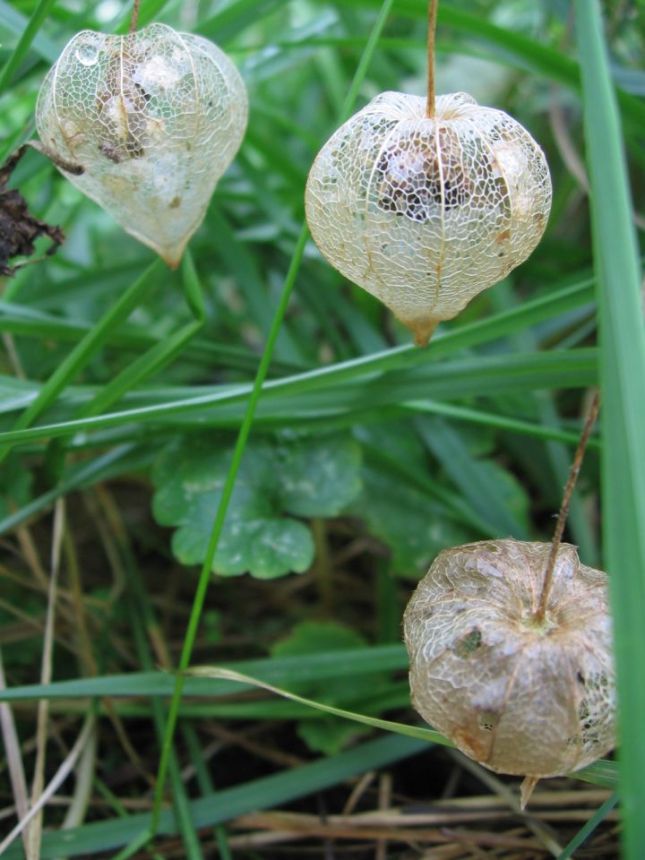 These curious little “chinese lanterns” were found in the meadow near the swimming pond and are the old fruits of ground cherry (Physalis sp.). The edible berries that were ripe inside the lanterns earlier in the summer, were obviously never found and are now rotting inside. Which is not to say that the seeds won’t germinate next spring…
These curious little “chinese lanterns” were found in the meadow near the swimming pond and are the old fruits of ground cherry (Physalis sp.). The edible berries that were ripe inside the lanterns earlier in the summer, were obviously never found and are now rotting inside. Which is not to say that the seeds won’t germinate next spring…
Now, we’ll slowly inch our way from fruits to flowers.
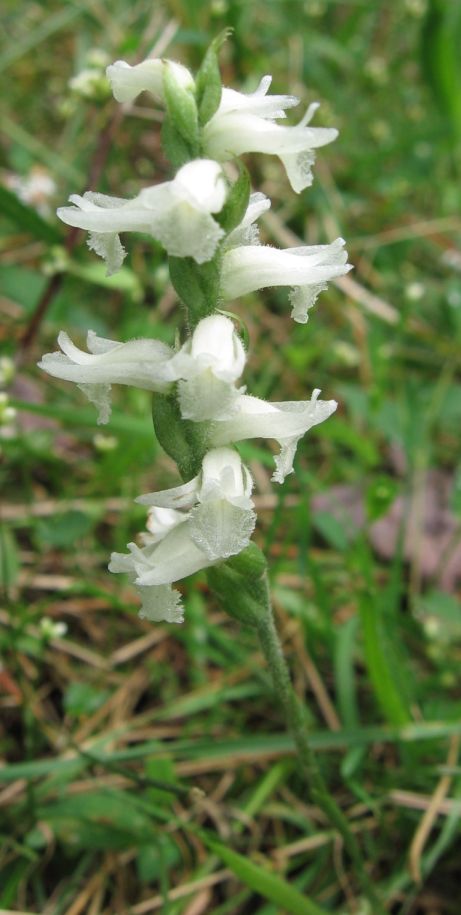 This lovely little orchid (around here, it is usually 4-6 inches tall) is called nodding ladies’ tresses (Spiranthes cernua) and is currently flowering in at least three different locations on the farm. It likes wet meadows and seepy areas, but at each location there are only very few plants.
This lovely little orchid (around here, it is usually 4-6 inches tall) is called nodding ladies’ tresses (Spiranthes cernua) and is currently flowering in at least three different locations on the farm. It likes wet meadows and seepy areas, but at each location there are only very few plants.
The exact opposite are several profusely growing smartweeds (Polygonum sp.).
Which, upon closer inspection, have almost orchid-like flowers, themselves…
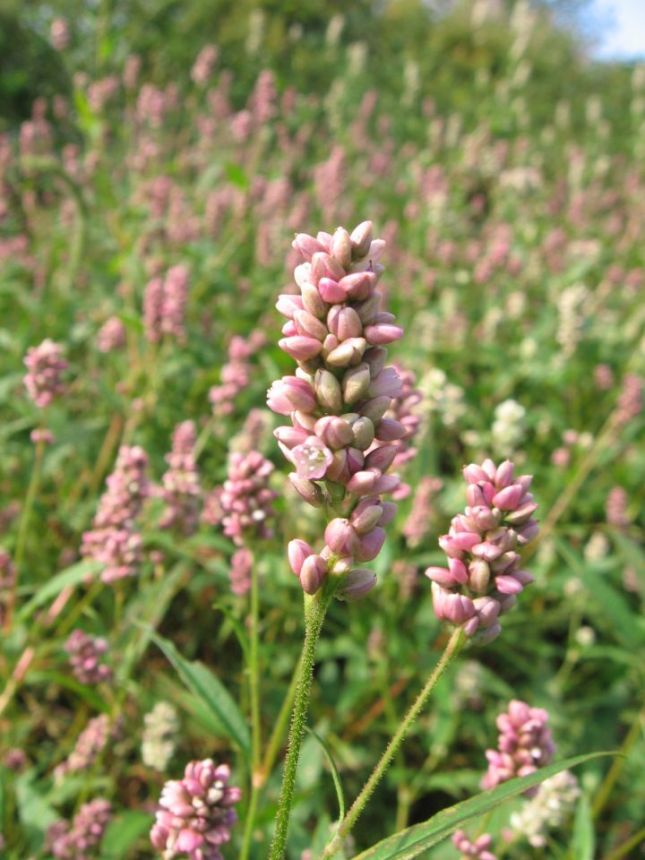 This species is the native Pennsylvania smartweed (Polygonum pensylvanicum). It is characterized by its dense flower heads of pink or white flowers and the conspicuous glands on the stem just below the flower heads.
This species is the native Pennsylvania smartweed (Polygonum pensylvanicum). It is characterized by its dense flower heads of pink or white flowers and the conspicuous glands on the stem just below the flower heads.
But other smartweed species grow nearby on the edge of the Beefield.
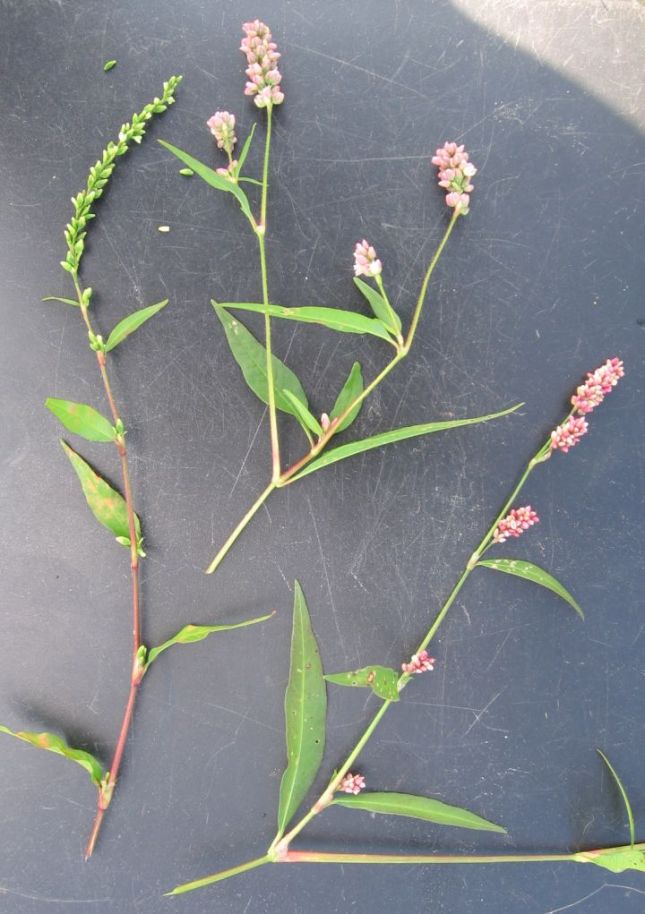 Left to right, you can compare the introduced waterpepper (Polygonum hydropiper), with narrow, elongate and nodding inflorescences of whitish flowers and leaves that are extremely peppery to the taste; the native Pennsylvania smartweed (P. pensylvanicum), with its glandular stems; and a third, yet unidentified, species with slightly smaller flowers and smooth stems.
Left to right, you can compare the introduced waterpepper (Polygonum hydropiper), with narrow, elongate and nodding inflorescences of whitish flowers and leaves that are extremely peppery to the taste; the native Pennsylvania smartweed (P. pensylvanicum), with its glandular stems; and a third, yet unidentified, species with slightly smaller flowers and smooth stems.
And, finally, the Aster family (which was introduced in the last blog posting):
 Annual fleabane (Erigeron annuus) is a native member of the aster family that begins flowering in May and can still be seen in full bloom at this time of the year along field edges and in extensively grazed pastures. To me, the biggest difference from the “true asters” is that the disk flowers of fleabane don’t seem to change color as they mature. Or at least one doesn’t get to see it, because the ray flowers turn from white to pink and fold themselves up to cover the maturing disk flowers (see bottom left flower head).
Annual fleabane (Erigeron annuus) is a native member of the aster family that begins flowering in May and can still be seen in full bloom at this time of the year along field edges and in extensively grazed pastures. To me, the biggest difference from the “true asters” is that the disk flowers of fleabane don’t seem to change color as they mature. Or at least one doesn’t get to see it, because the ray flowers turn from white to pink and fold themselves up to cover the maturing disk flowers (see bottom left flower head).
You can see the change in color of the disk flowers from yellow to purple in the left (more pinkish) aster below:
 The color of the ray flowers in New England aster (Symphyotricum novae-angliae) does not change with time but is a characteristic to each plant. This picture shows a (rarer) pink and a (more common) purple form growing next to each other. Where you see a clump of pink New England aster, you will likely see another clump next year.
The color of the ray flowers in New England aster (Symphyotricum novae-angliae) does not change with time but is a characteristic to each plant. This picture shows a (rarer) pink and a (more common) purple form growing next to each other. Where you see a clump of pink New England aster, you will likely see another clump next year.
The wet meadow west of the former Banjo Mountain Cafe, like many other wet meadows, is currently dominated by the lavender flowers of purple-stemmed aster (Symphyotricum puniceum). One clump of New England aster (purple flowers, bottom right) contrasts with the sea of purple-stemmed aster (lavender flowers). Below, a close-up comparison of the two species:
One clump of New England aster (purple flowers, bottom right) contrasts with the sea of purple-stemmed aster (lavender flowers). Below, a close-up comparison of the two species:
 Purple-stemmed aster (lavender and whitish flowers on left) tends to occur in wetter places and usually has at least somewhat toothed leaves, while New England aster (purple flowers on right) tends to occur in dryer places and its leaves are never toothed. Both are rather hairy, can have purplish stems, and have sessile leaves with clasping leaf bases.
Purple-stemmed aster (lavender and whitish flowers on left) tends to occur in wetter places and usually has at least somewhat toothed leaves, while New England aster (purple flowers on right) tends to occur in dryer places and its leaves are never toothed. Both are rather hairy, can have purplish stems, and have sessile leaves with clasping leaf bases.
Road banks are a great place to spot asters. This site on Harlemville Road has at least five species growing next to each other.
Smooth-leaved aster (Symphyotrichum laevis) has lavender ray flowers and the entire plant is super smooth, almost waxy.
 The leaves of smooth-leaved aster are narrow, sessile, and not at all toothed.
The leaves of smooth-leaved aster are narrow, sessile, and not at all toothed.
Right next to it, on the dry road bank, grows heart-leaved aster (Symphyotrichum cordifolium), which has a very similar ray flower color, but very different leaves.
 The leaves of heart-leaved aster are heart-shaped (at least the ones low on the plant), rough to the touch, strongly toothed, and have a long, sometimes slightly winged, petiole.
The leaves of heart-leaved aster are heart-shaped (at least the ones low on the plant), rough to the touch, strongly toothed, and have a long, sometimes slightly winged, petiole.
Dry road banks are also a good place to spot wavy-leaved aster (Symphyotricum undulatum), another species with lavender ray flowers.
 The leaves of wavy-leaved aster can be hairy or smooth, toothed or not, but they always have a distinct winged petiole which clasps the stem in a characteristic way.
The leaves of wavy-leaved aster can be hairy or smooth, toothed or not, but they always have a distinct winged petiole which clasps the stem in a characteristic way.
Willowleaf aster (Symphyotricum praealtus) is another species that likes to grow in the open, often along field edges. It has ray flowers that are almost white with just a hint of lavender. It is superficially very similar to panicled aster, but distinguished by its narrow, willow-like leaves.
 The leaves of willowleaf aster are never toothed (those of panicled aster usually have at least a few teeth) and have a characteristic, isodiametric network of secondary veins.
The leaves of willowleaf aster are never toothed (those of panicled aster usually have at least a few teeth) and have a characteristic, isodiametric network of secondary veins.
Finally, I would like to share a few aster species from the shaded forest understory with you:
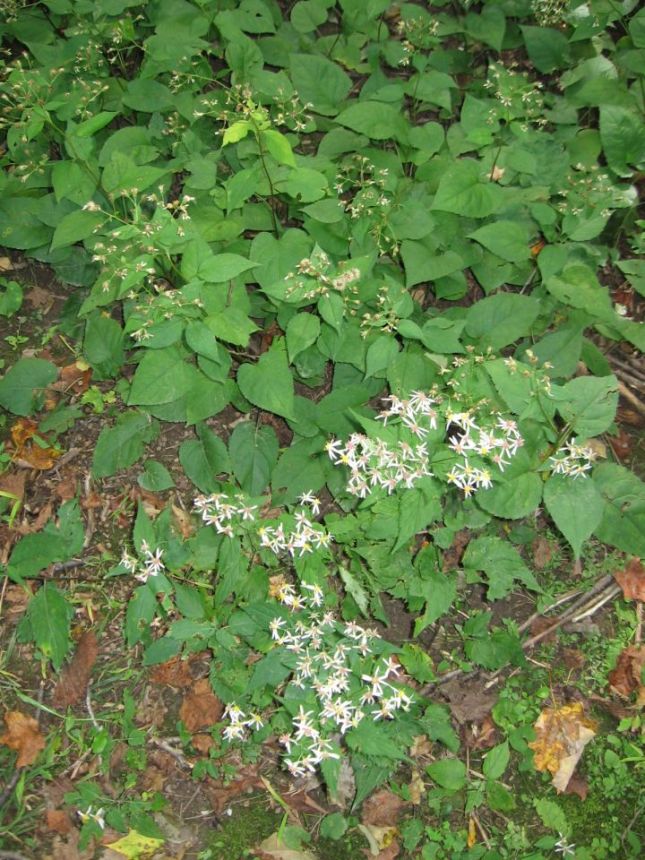 This picture from near Ben Ocean’s bridge contrasts white wood aster (Eurybia divaricata) in the foreground with Schreber’s aster (Eurybia schreberi) in the back. The almost ubiquitous white wood aster has narrower, more strongly toothed leaves and its flower heads tend to be arranged in a flat-topped inflorescence. The rarer Schreber’s aster tends to have more elongate inflorescences, the leaves are broader and the colonies tend to be composed of flowering plants as well as a ground cover of basal leaves.
This picture from near Ben Ocean’s bridge contrasts white wood aster (Eurybia divaricata) in the foreground with Schreber’s aster (Eurybia schreberi) in the back. The almost ubiquitous white wood aster has narrower, more strongly toothed leaves and its flower heads tend to be arranged in a flat-topped inflorescence. The rarer Schreber’s aster tends to have more elongate inflorescences, the leaves are broader and the colonies tend to be composed of flowering plants as well as a ground cover of basal leaves.
Another rarer woodland aster is large-leaved aster (Eurybia macrophylla). It is superficially very similar to Schreber’s aster, but the ray flowers tend to have a lavender tinge and a magnifying glass reveals tiny glands that cover the stems near the inflorescence. A patch of this aster grows west of the Baba Yaga house at the base of Phudd Hill.
Two goldenrod species are currently very prevalent in the forest along the Agawamuck:
 Zig-zag goldenrod (Solidago flexicaulis) has broad leaves and a stem that tends to zig zag from one leaf to the next. It prefers the deep alluvial soil near Ben Ocean’s bridge.
Zig-zag goldenrod (Solidago flexicaulis) has broad leaves and a stem that tends to zig zag from one leaf to the next. It prefers the deep alluvial soil near Ben Ocean’s bridge.
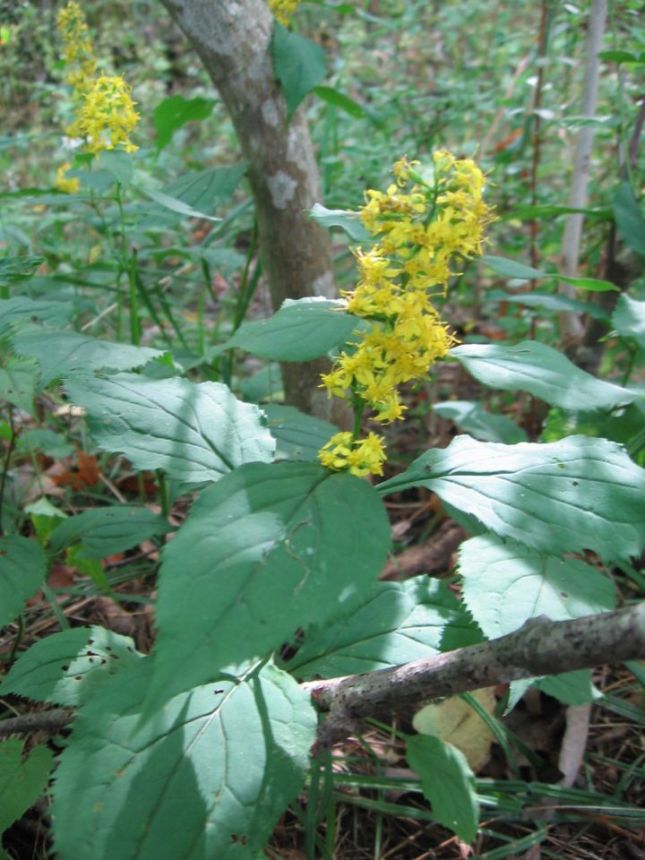 The flowers of zig-zag goldenrod are not arranged at the top of the stalk and above the leaves, like in most other goldenrods, but grow from the axils of the leaves, thus alternating with the leaves along the stalk.
The flowers of zig-zag goldenrod are not arranged at the top of the stalk and above the leaves, like in most other goldenrods, but grow from the axils of the leaves, thus alternating with the leaves along the stalk.
Bluestem goldenrod (Solidago caesia) grows in slightly dryer, but also shaded habitat. Some nice patches can be observed on the trail to the swim pond.
 Bluestem goldenrod also alternates flower clusters and leaves. The leaves are long and narrow, the extremely smooth stem is sometimes bluish/purplish-colored and often has a waxy cover that can easily be wiped off.
Bluestem goldenrod also alternates flower clusters and leaves. The leaves are long and narrow, the extremely smooth stem is sometimes bluish/purplish-colored and often has a waxy cover that can easily be wiped off.
